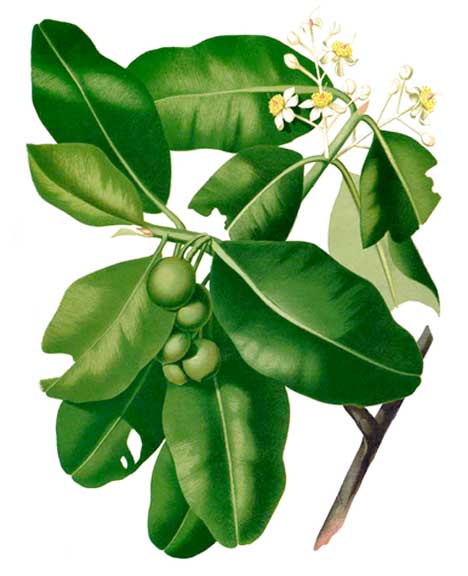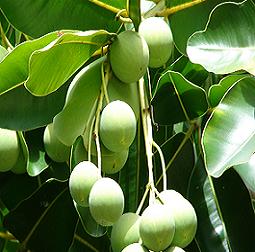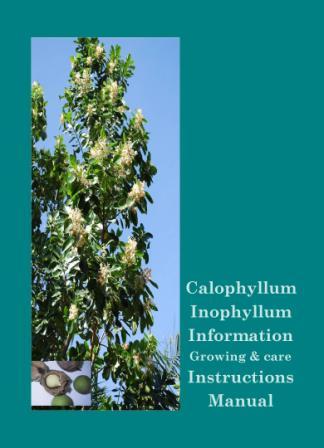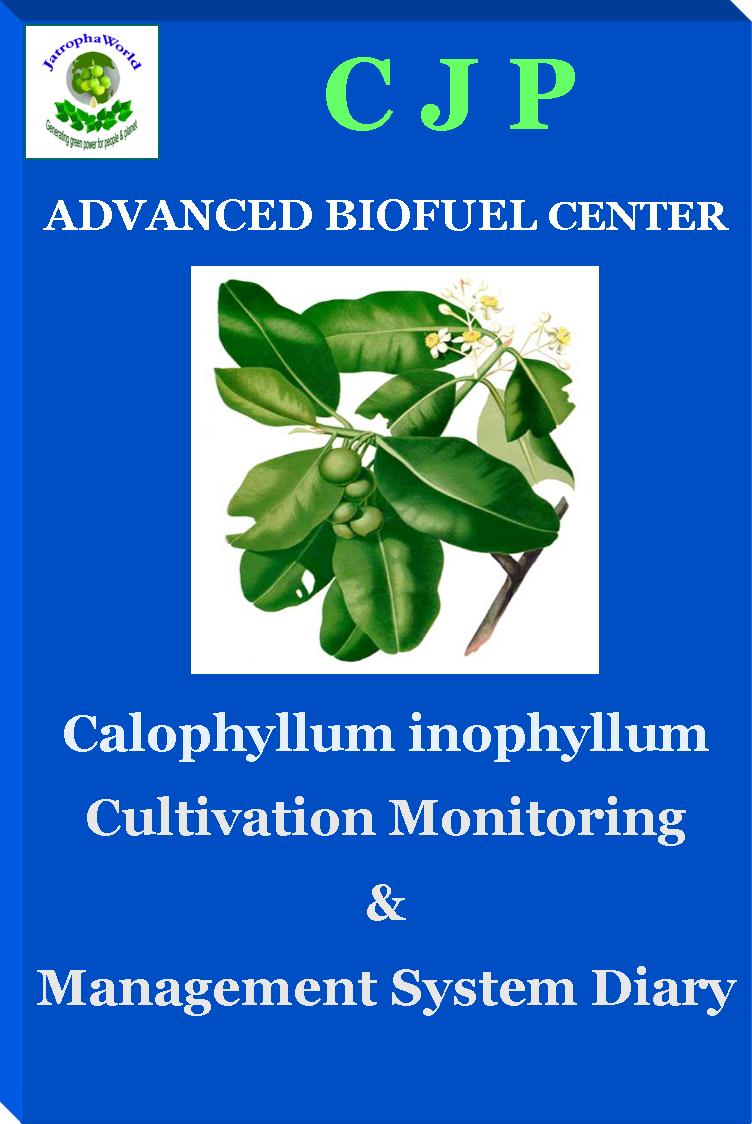 |
|
|||
|
|
| |
 |
|
Calophyllum inophyllum L. Indian Laurel tree with great Potential for Biodiesel
BOTANICAL DESCRIPTION Preferred scientific name Calophyllum inophyllum L. Size Calophyllum inophyllum L is a large tree of shorelines and coastal forests. It usually grows 12–20 m (40–65 ft) in height, but open-grown trees can become wider than they are tall, often leaning, with broad, spreading crowns. Trees growing along the shoreline may reach out with trunks almost parallel to the ground. The tree can often be recognized at a distance by its large, spread¬ing horizontal branches. Flowers It bears clusters of 4–15 fragrant white flowers about 2.5 cm (1 in) across and 8–14 mm (0.3–0.6 in) long on long, sturdy stalks in leaf axils. There are 4–8 oblong petals. Trees may flower all year, but flowering is heaviest in late spring/early summer and late fall in the northern hemisphere. Leaves The opposite leaves are dark green, shiny, and hairless with broadly elliptical blades 10–20 cm (4–8 in) long and 6–9 cm (2.4–3.6 in) wide. Both the tip and base of the leaves are rounded. Leaf veins run parallel to each other and perpendicular to the midrib. The scientific name Calophyllum comes from the Greek words for “beautiful leaf.” Fruit The ball-shaped, light green fruits grow in clusters. Fruits are 2–5 cm (0.8–2 in) in diameter. The skin, which turns yellow and then brown and wrinkled when the fruit is ripe, covers the thin pulp, the shell, a corky inner layer, and a single seed kernel. Fruits are usually borne twice a year. Seeds One large brown seed 2–4 cm (0.8–1.6 in) in diameter is found in each fruit. Seeds are prepared by cleaning off the skin and husk from the shell of the seed; there are 100–200 seeds/kg , with shells intact but husks removed. Distribution Calophyllum inophyllum L is native to tropical shores across the Pacific and Indian Oceans, from Madagascar to Tahiti and the Marquesas Islands. The tree is common in India, Indonesia, northern Australia, and the Philippines. Calophyllum inophyllum L is native northwards to the Northern Marianas islands and the Ryukyu Islands in southern Japan and westward throughout Polynesia except Hawai‘i, where it was introduced by the early Polynesian settlers. ENVIRONMENTAL PREFERENCES AND TOLERANCES Climate Calophyllum inophyllum L grows in warm temperatures in wet or moderate conditions. It is not suited to high elevations, cool areas, or very dry conditions. Elevation range Up to 800 m (2000 ft) Mean annual rainfall 1000–5000 mm (40–200 in) Rainfall pattern Calophyllum inophyllum L prefers climates with summer, winter, or uniform rainfall patterns. Dry season duration (consecutive months with <_0mm [1.6 in] rainfall) 4–5 months Mean annual temperature 18–33°C (64–91°F) Minimum temperature tolerated 8°C (46°F) Soils Calophyllum inophyllum L tolerates a wide range of soils. It grows best in sandy well drained soils in coastal areas but will tolerate clays, calcareous soils, and rocky soils. Soil texture It tolerates light to medium soils (sands, sandy loams, loams, and sandy clay loams. Soil drainage Freely draining as well as soils with impeded drainage or seasonal water logging is acceptable. Soil acidity Neutral to acid soils (pH 7.4–4.0) It tolerates shallow and saline soils. Tolerances Calophyllum inophyllum L is a hardy tree of tropical coastal areas that tolerates wind, salt spray, drought, and brief periods of waterlogged soil. It does not tolerate much shade or cold weather. Drought Calophyllum inophyllum L can tolerate 4–5 months of drought in its natural littoral and riparian environments. Full sun Calophyllum inophyllum L prefers full sun, and only light shade is tolerated. Fire Calophyllum inophyllum L is moderately tolerant of wildfire, once the bark thickens. Frost Calophyllum inophyllum L grows only in warm climates and does not tolerate frost. Water logging Calophyllum inophyllum L tolerates occasional water logging in coastal areas. Salt spray and wind Calophyllum inophyllum L grows in areas subject to sea breezes and salt spray.
Calophyllum inophyllum L is moderately easy to propagate by seed, and local seed sources are easily found in the Pacific Islands. Germination and initial growth is slow, however, and seedlings should be started 6 months before they are required. Once outplanted, seedlings are hardy but slow growing. They prefer full sun and tolerate wind, salt spray, and drought.
PLANTATION MANAGEMENT OF CALOPHYLLUM INOPHYLLUM L TREE CULTIVATION TECHNOLOGY The productive cultivation of Calophyllum inophyllum L needs to be scientifically managed for better growth and production. The growth and yield of the plant could be improved through effective management practices. The enhanced cultivation technology and improved inputs developed by CJP may provide plenty of biodiesel without displacing food crop and without utilizing prime food land in terms of sustainable farming techniques The key factors that can influence the oil yield of Calophyllum inophyllum L are:
CJP carefully manages Calophyllum inophyllum L cultivation, with advanced crop practices suitable to local soil, weather, pest, and disease conditions to ensure the high amount of oil as we have developed enhanced technology with regards to:-
The key factors governing profitability of large scale production are:
CJP’s Researchers have developed standardized techniques for growing Calophyllum inophyllum L on large scale. CJP ensures Organic Calophyllum inophyllum L cultivation right from the land preparation, crop management to production of end product. CJP’S “Calophyllum inophyllum L Cultivation Technology” is available at an affordable Price Calophyllum inophyllum Crop Information Growing & Care Instruction Manual and Monitoring & management system
As all biological organisms require care and attention, the need to draw Growing Instructions was being felt by all concerned Therefore
keeping in view Various concerns and problems of a new Grower; CJP being “The
Centre of Excellence” has designed Calophyllum Inophyllum L Growing & Care
Instructions Manual with Monitoring & Management System Diary
on the basis of our own tried, tested, developed and experienced Plant
Propagation and Cultivation The Calophyllum inophyllum L Growing & Care Instructions manual provides basic guidance for the project developers to help ensure successful Calophyllum inophyllum L planting projects. Proper planning, planting and maintenance are the key for growing flourishing plants. Simply putting a plant in the ground is not enough. Careful thought must be given to the purpose of the planting, location of the planting and how the Calophyllum inophyllum L will be cared for once they are in the ground. A properly planted and maintained plant will grow faster and live longer than one that is incorrectly planted. This booklet is organized as a step-by-step checklist of fundamentals to help you with your Calophyllum inophyllum L planting project We have sincerely tried to put all steps in nutshell and hope it will be a useful tool in growing your Biodiesel Plantation Both the Calophyllum inophyllum publications are available Order Just Know Agricultural Extension Kit CJP has specifically developed and designed a unique kit for Calophyllum inophyllum L plantation and crop care for 1 hectare called: “Agricultural Extension Kit” – a key to your fuel farm “just enables & encourages the farmers/ new growers to start the Biodiesel crop cultivation in a right and prefect manner by adopting the concept of “sustainable agriculture”. Calophyllum inophyllum Starter Kit: Calophyllum inophyllum Agri- Extension Kit contains 1. SRIPHL CIO3 Elite planting stock for cultivation in 1 ha 2. an easy- to- follow growing and crop care instructions manual 3. a very typical monitoring and management diary Order Just Know Calophyllum Inophyllum Elite Seeds
TERMS & CONDITIONS Packing: 2,10,20,50 KG Bags Shipment: FOB/CIF Minimum QUANTITY: 3.0 tons by sea, 2 kg by air PRICE: quote? Working time: 30 days After Payment ALL PAYMENT TERM: 100 % Advance Phyto sanitary charge: included Order Just Know ECONOMIC ANALYSIS & BUSINESS PLANS
For detailed cost benefit ratio obtain CALOPHYLLUM INOPHYLLUM BIODIESEL BUSINESS PLAN Sample/ Ready Built Business Plans Sample/ready built Biodiesel business plans are drawn in universal scenario based on optimum conditions for growing the biodiesel crop worldwide and on crop specific science, agronomy and economy in wider context Sample/readymade business plan are available for 20 hectare, 100 hectare and 500 hectare as per details on page http://www.jatrophaworld.org/biodiesel_business_plan_95.html Feasibility Study Report We recommend carrying out Feasibility Study Report for project size of 5000 hectares or more to determine the land identification and suitability of growing the Calophyllum inophyllum Customized, Complete & Comprehensive Biodiesel Business Plan
For formulation and creation of customized Calophyllum inophyllum biodiesel business plan for the size of 1000 hectare or more kindly contact to Director Business Development for detailed quote for Calophyllum inophyllum : the 2ndgeneration biodiesel crop Order Just Know
|
© 2004- 2025 ABC-Advanced Biofuel center ,, All Rights Reserved |

 Calophyllum
inophyllum L. is a medium-sized to large evergreen tree that averages 8–20 m
(25–65 ft) in height with a broad spreading crown of irregular branches. The
tree supports a dense canopy of glossy, elliptical leaves, fragrant white
flowers, and large round nuts. It grows along coastal areas and adjacent
lowland forests, although it occasionally occurs inland at higher elevations.
It is native to east Africa, India, Southeast Asia, Australia, and the South
Pacific. It has been widely planted throughout the tropics and is naturalized
in the main Hawaiian Islands. Calophyllum inophyllum L. is a useful tree for
coastal shelterbelts, windbreaks, and strand reforestation because it grows
well despite the wind, salt spray, drought, and occasional flooding common to
beach environments. It even withstands typhoons.
Calophyllum
inophyllum L. is a medium-sized to large evergreen tree that averages 8–20 m
(25–65 ft) in height with a broad spreading crown of irregular branches. The
tree supports a dense canopy of glossy, elliptical leaves, fragrant white
flowers, and large round nuts. It grows along coastal areas and adjacent
lowland forests, although it occasionally occurs inland at higher elevations.
It is native to east Africa, India, Southeast Asia, Australia, and the South
Pacific. It has been widely planted throughout the tropics and is naturalized
in the main Hawaiian Islands. Calophyllum inophyllum L. is a useful tree for
coastal shelterbelts, windbreaks, and strand reforestation because it grows
well despite the wind, salt spray, drought, and occasional flooding common to
beach environments. It even withstands typhoons. PROPAGATION
PROPAGATION
 The
planting, looking after and harvesting plants is an important factor and it
requires a lot of knowledge, skill and techniques viz: the best planting season
to make the plant early matured, then an amount of seeds to be planted, an
irrigation & fertilization method, a
control method of weeds , investigate quality, yield, and degree of occurrence
of several troubles .
The
planting, looking after and harvesting plants is an important factor and it
requires a lot of knowledge, skill and techniques viz: the best planting season
to make the plant early matured, then an amount of seeds to be planted, an
irrigation & fertilization method, a
control method of weeds , investigate quality, yield, and degree of occurrence
of several troubles . Technologies and Practices to help you grow a
Failsafe Calophyllum inophyllum L Fuel Farm
Technologies and Practices to help you grow a
Failsafe Calophyllum inophyllum L Fuel Farm We make the integration of our experience, expertise
and professional knowledge with your information and formulate customized
biodiesel business plan. In undertaking this Technical & Financial Inputs
assessment, we shall have relied on Primary inputs supplied by you, our IPR
knowledge & research experiences and expertise in the field; on industry
experts and secondary information derived from recognized public sources and
via CJP's database and multi-client reports.
We make the integration of our experience, expertise
and professional knowledge with your information and formulate customized
biodiesel business plan. In undertaking this Technical & Financial Inputs
assessment, we shall have relied on Primary inputs supplied by you, our IPR
knowledge & research experiences and expertise in the field; on industry
experts and secondary information derived from recognized public sources and
via CJP's database and multi-client reports.